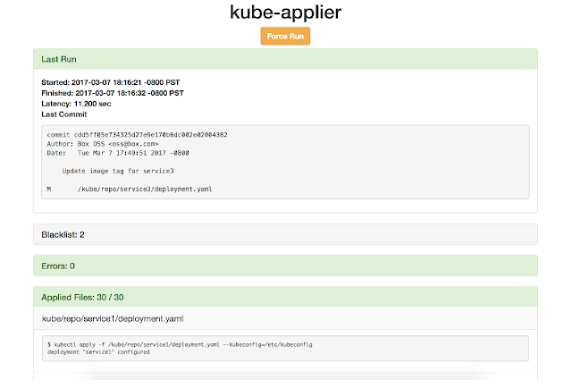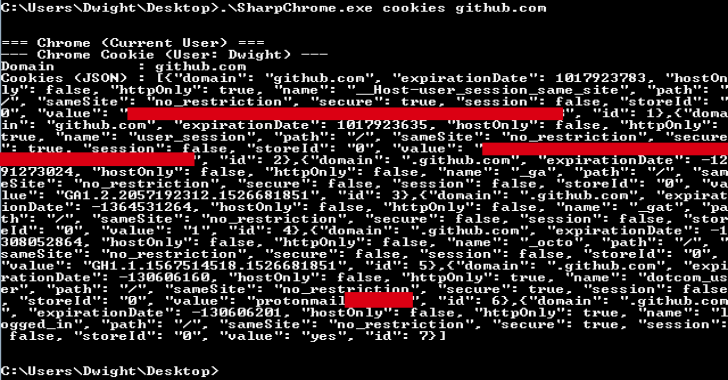Kube-Applier is a service that enables continuous deployment of Kubernetes objects by applying declarative configuration files from a Git repository to a Kubernetes cluster.
kube-applier runs as a Pod in your cluster and watches the Git repo to ensure that the cluster objects are up-to-date with their associated spec files (JSON or YAML) in the repo.
At a specified interval, kube-applier performs a “full run”, issuing kubectl apply commands for all JSON and YAML files within the repo.
When a new commit to the repo occurs, kube-applier performs a “quick run”, issuing apply commands only for files that have changed since the last run.
Quick runs and full runs are handled separately and concurrently.
kube-applier serves a status page and provides metrics for monitoring.
- Go (1.7+)
- Docker (17.05+)
- Kubernetes cluster
- kube-applier generally supports any Kubernetes server release, assuming that you are installing a compatible kubectl client in your Dockerfile.
- The kubectl version specified in the Dockerfile must be either the same minor release as the cluster API server, or one release behind the server (e.g. client 1.3 and server 1.4 is fine, but client 1.4 and server 1.3 is not).
- There are several known problems with
kubectl applythat may affect your use of kube-applier. Some examples:- Releases prior to 1.6.0 are subject many known issues with using
kubectl applyto apply ThirdPartyResource objects. - 1.5 and 1.6 releases before 1.5.8 and 1.6.3 are not supported due to an issue with namespaces, fixed here.
- Releases prior to 1.6.0 are subject many known issues with using
Download the source code and build the container image.
$ go get github.com/box/kube-applier
$ cd $GOPATH/src/github.com/box/kube-applier
$ make container
You will need to push the image to a registry in order to reference it in a Kubernetes container spec.
We suggest running kube-applier as a Deployment (see demo/ for example YAML files). We only support running one replica at a time at this point, so there may be a gap in application if the node serving the replica goes hard down until it is rescheduled onto another node.
IMPORTANT: The Pod containing the kube-applier container must be spawned in a namespace that has write permissions on all namespaces in the API Server (e.g. kube-system).
Required
REPO_PATH– (string) Absolute path to the directory containing configuration files to be applied. It must be a Git repository or a path within one. All .json and .yaml files within this directory (and its subdirectories) will be applied, unless listed on the blacklist or excluded from the whitelist.LISTEN_PORT– (int) Port for the container. This should be the same port specified in the container spec.
Optional
SERVER– (string) Address of the Kubernetes API server. By default, discovery of the API server is handled by kube-proxy. If kube-proxy is not set up, the API server address must be specified with this environment variable (which is then written into a kubeconfig file on the backend). Authentication to the API server is handled by service account tokens. See Accessing the Cluster for more info.BLACKLIST_PATH– (string) Path to a “blacklist” file which specifies files that should not be applied. This path should be absolute (e.g./k8s/conf/kube_applier_blacklist), not relative toREPO_PATH(although you may want to check the blacklist file into the repo). The blacklist file itself should be a plaintext file, with a file path on each line. Each of these paths should be relative toREPO_PATH(for example, ifREPO_PATHis set to/git/repo, and the file to be blacklisted is/git/repo/apps/app1.json, the line in the blacklist file should beapps/app1.json).WHITELIST_PATH– (string) Path to a “whitelist” file which is used to make the applier consider a specific subset of files from the repo. Only the files listed in the whitelist file will be considered for apply. Empty whitelist (or unset env var) means all files in repo are eligible to be applied. In case of a file is listed in both the whitelist and the blacklist, the file is not applied. The environment variable and file itself should formatted the same as for the blacklist above.
NOTE The blacklist and whitelist files support line comments. A single line gets ignored if the first non-blank character is # in that line.
POLL_INTERVAL_SECONDS– (int) Number of seconds to wait between each check for new commits to the repo (default is 5). Set to 0 to disable the wait period.FULL_RUN_INTERVAL_SECONDS– (int) Number of seconds between automatic full runs (default is 300, or 5 minutes). Set to 0 to disable the wait period.DIFF_URL_FORMAT– (string) If specified, allows the status page to display a link to the source code referencing the diff for a specific commit.DIFF_URL_FORMATshould be a URL for a hosted remote repo that supports linking to a commit hash. Replace the commit hash portion with “%s” so it can be filled in by kube-applier (e.g.https://github.com/kubernetes/kubernetes/commit/%s).LOG_LEVEL– (int) Sets the-vflag on allkubectlcommands run. Use this option to configure more verbose logging. If not specified, the-vflag is not set onkubectlcommands defaulting to standard log verbosity.
There are two ways to mount the Git repository into the kube-applier container.
- Git-sync sidecar container
Git-sync keeps a local directory up to date with a remote repo. The local directory resides in a shared emptyDir volume that is mounted in both the git-sync and kube-applier containers.
Reference the git-sync repo for setup and usage.
- Host-mounted volume
Mount a Git repository from a host directory. This can be useful when you want kube-applier to apply changes to an object without checking the modified spec file into a remote repo.
“volumes”: [
{
“hostPath”: {
“path”:
},
“name”: “repo-volume”
}
…
]
What happens if the contents of the local Git repo change in the middle of a kube-applier run?
If there are changes to files in the $REPO_PATH directory during a kube-applier run, those changes may or may not be reflected in that run, depending on the timing of the changes.
Given that the $REPO_PATH directory is a Git repo or located within one, it is likely that the majority of changes will be associated with a Git commit. Thus, a change in the middle of a run will likely update the HEAD commit hash, which will immediately trigger another run upon completion of the current run (regardless of whether or not any of the changes were effective in the current run). However, changes that are not associated with a new Git commit will not trigger a run.
If I remove a configuration file, will kube-applier remove the associated Kubernetes object?
No. If a file is removed from the $REPO_PATH directory, kube-applier will no longer apply the file, but kube-applier WILL NOT delete the cluster object(s) described by the file. These objects must be manually cleaned up using kubectl delete.
In rare cases, you may wish to trigger a kube-applier run without checking in a commit or waiting for the next scheduled run (e.g. some of your files failed to apply because of some background condition in the cluster, and you have fixed it since the last run). This can be accomplished with the “Force Run” button on the status page, which starts a run immediately if no run is currently in progress, or queues a run to start upon completion of the current run. Only one run may sit in the queue at any given time.

kube-applier hosts a status page on a webserver, served at the service endpoint URL. The status page displays information about the most recent apply run, including:
- Run Type
- Start and end times
- Latency
- Most recent commit
- Whitelisted files
- Blacklisted files
- Errors
- Files applied successfully
The HTML template for the status page lives in templates/status.html, and static/ holds additional assets.
kube-applier uses Prometheus for metrics. Metrics are hosted on the webserver at /metrics (status UI is the index page). In addition to the Prometheus default metrics, the following custom metrics are included:
- run_latency_seconds – A Summary that keeps track of the durations of each apply run, tagged with the run type and a boolean for whether or not the run was a success (i.e. no failed apply attempts).
- file_apply_count – A Counter for each file that has had an apply attempt over the lifetime of the container, incremented with each apply attempt and tagged by the filepath and the result of the attempt.
The Prometheus HTTP API (also see the Go library) can be used for querying the metrics server.

















